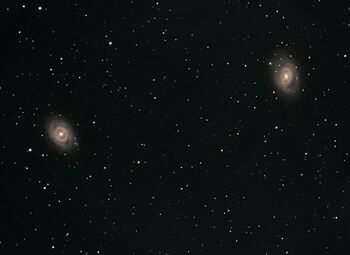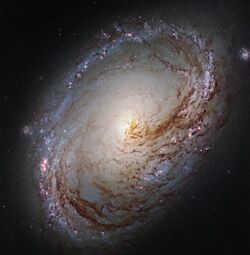Astronomy:M96 Group
Coordinates: ![]() 10h 48m 34.7s, +12° 40′ 15″
10h 48m 34.7s, +12° 40′ 15″
| M96 Group | |
|---|---|
 | |
| Observation data (Epoch J2000[1][2]) | |
| Constellation(s) | Leo[3][4] |
| Right ascension | 10h 48m 34.7s [1] |
| Declination | +12° 40′ 15″ [1] |
| Brightest member | M96[3][4] |
| Number of galaxies | 8-24[3][4][5][6] |
| Distance (co-moving) | 11.3 Mpc (37 Mly) [1] |
| Other designations | |
| Leo I Group,[6] LGG 217,[3] NOGG H 507,[4] NOGG P1 498,[4] NOGG P2 507[4] | |
The M96 Group (also known as the Leo I Group) is a group of galaxies in the constellation Leo. This group contains between 8 and 24 galaxies, including three Messier objects.[3][4][5][6] It also contains the Leo Ring. The group is one of many groups that lies within the Virgo Supercluster (the combined Local Group and Virgo cluster).[7]
Members
The table below lists galaxies that have been consistently identified as group members in the Nearby Galaxies Catalog,[5] the survey of Fouque et al.,[6] the Lyons Groups of Galaxies (LGG) Catalog,[3] and the three group lists created from the Nearby Optical Galaxy sample of Giuricin et al.[4]
| Name | Type[8][9] | R.A. (J2000)[8][9] | Dec. (J2000)[8][9] | Redshift (km/s)[8][9] | Apparent Magnitude[8][9] |
|---|---|---|---|---|---|
| M95 | SB(r)b | 10h 43m 57.7s | +11° 42′ 14″ | 778 ± 4 | 11.4 |
| M96 | SAB(rs)ab | 10h 46m 45.7s | +11° 49′ 12″ | 897 ± 4 | 10.1 |
| M105 | E1 | 10h 47m 49.6s | +12° 34′ 54″ | 911 ± 2 | 10.2 |
| NGC 3299 | SAB(s)dm | 10h 36m 23.8s | +12° 42′ 27″ | 641 ± 6 | 13.3 |
| NGC 3377 | E5.5 | 10h 47m 42.4s | +13° 59′ 08″ | 665 ± 2 | 11.2 |
| NGC 3384 | SB(s)0 | 10h 48m 16.9s | +12° 37′ 46″ | 704 ± 2 | 10.9 |
| NGC 3412 | SB(s)0 | 10h 50m 53.3s | +13° 24′ 44″ | 841 ± 2 | 11.5 |
| NGC 3489 | SAB(rs)0 | 11h 00m 18.6s | +13° 54′ 04″ | 677 ± 2 | 11.1 |
| Leo Ring | H I region | 10h 48m 19.0s | +12° 41′ 21″ | 960 ± 80 |
Nearby groups
The Leo Triplet, which includes the spiral galaxies M65, M66, and NGC 3628,[3][4][5] is located physically near the M96 Group.[10] Some group identification algorithms actually identify the Leo Triplet at part of the M96 Group.[4][6] The two groups may actually be separate parts of a much larger group.[10]

See also
- Leo II Groups
- Virgo II Groups
- Virgo III Groups
References
- ↑ 1.0 1.1 1.2 1.3 "MESSIER 096 GROUP". NASA/IPAC Extragalactic Database. http://ned.ipac.caltech.edu/cgi-bin/objsearch?objname=Leo+Group&extend=no&hconst=73&omegam=0.27&omegav=0.73&corr_z=1&out_csys=Equatorial&out_equinox=J2000.0&obj_sort=RA+or+Longitude&of=pre_text&zv_breaker=30000.0&list_limit=5&img_stamp=YES. Retrieved 2015-11-05.
- ↑ "NAME M96 GROUP". SIMBAD. Centre de données astronomiques de Strasbourg. http://simbad.u-strasbg.fr/simbad/sim-basic?Ident=NAME+M96+GROUP.
- ↑ 3.0 3.1 3.2 3.3 3.4 3.5 3.6 A. Garcia (1993). "General study of group membership. II - Determination of nearby groups". Astronomy and Astrophysics Supplement 100: 47–90. Bibcode: 1993A&AS..100...47G.
- ↑ 4.00 4.01 4.02 4.03 4.04 4.05 4.06 4.07 4.08 4.09 G. Giuricin; C. Marinoni; L. Ceriani; A. Pisani (2000). "Nearby Optical Galaxies: Selection of the Sample and Identification of Groups". Astrophysical Journal 543 (1): 178–194. doi:10.1086/317070. Bibcode: 2000ApJ...543..178G.
- ↑ 5.0 5.1 5.2 5.3 R. B. Tully (1988). Nearby Galaxies Catalog. Cambridge: Cambridge University Press. ISBN 0-521-35299-1.
- ↑ 6.0 6.1 6.2 6.3 6.4 P. Fouque; E. Gourgoulhon; P. Chamaraux; G. Paturel (1992). "Groups of galaxies within 80 Mpc. II - The catalogue of groups and group members". Astronomy and Astrophysics Supplement 93: 211–233. Bibcode: 1992A&AS...93..211F.
- ↑ R. B. Tully (1982). "The Local Supercluster". Astrophysical Journal 257: 389–422. doi:10.1086/159999. Bibcode: 1982ApJ...257..389T.
- ↑ 8.0 8.1 8.2 8.3 8.4 "NASA/IPAC Extragalactic Database". Results for various galaxies. http://nedwww.ipac.caltech.edu/. Retrieved 2006-10-24.
- ↑ 9.0 9.1 9.2 9.3 9.4 "SIMBAD". http://simbad.u-strasbg.fr. Retrieved 2015-10-24.
- ↑ 10.0 10.1 L. Ferrarese; H. C. Ford; J. Huchra; R. C. Kennicutt Jr.; J. R. Mould; S. Sakai; W. L. Freedman; P. B. Stetson et al. (2000). "A Database of Cepheid Distance Moduli and Tip of the Red Giant Branch, Globular Cluster Luminosity Function, Planetary Nebula Luminosity Function, and Surface Brightness Fluctuation Data Useful for Distance Determinations". Astrophysical Journal Supplement 128 (2): 431–459. doi:10.1086/313391. Bibcode: 2000ApJS..128..431F.
- ↑ "A galactic maelstrom". http://www.spacetelescope.org/images/potw1535a/. Retrieved 31 August 2015.
External links
 |

